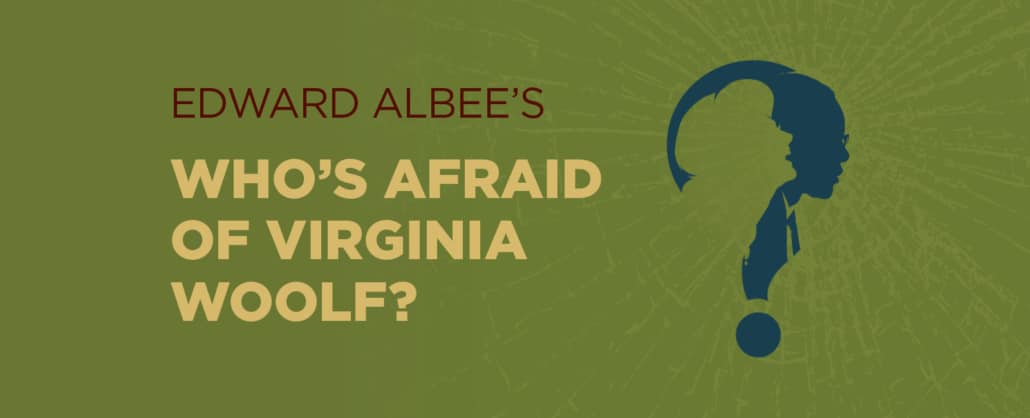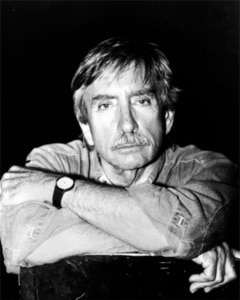DCPA NEWS CENTER
Enjoy the best stories and perspectives from the theatre world today.
Enjoy the best stories and perspectives from the theatre world today.

By Joanne Ostrow
Imagine the audience’s shock in 1962 when Edward Albee’s first full-length play had its Broadway debut: On the set of a bland living room, the crude baiting and vicious game-playing of a middle-aged married couple unfolds like a prizefight. The devastating language, brutal wit and merciless puncturing of illusions— it was all new onstage. Who’s Afraid of Virginia Woolf? was a sharp break from the shallow entertainments of conventional American theater.
Edward Albee’s masterpiece remains powerful, shocking and oddly relevant today.
In style, Who’s Afraid Virginia Woolf? has been likened by critics to the European theater of the absurd. The title is a singsong academic pun on “the big bad wolf,” as in, Albee once explained, who’s afraid of living life without false illusions?
The setting is the living room of a New England college associate professor, George, and his wife Martha, as they entertain a new faculty member and his wife, Nick and Honey, through a boozy after-party of escalating verbal warfare. George calls his and Martha’s sparring “merely…exercising.”
In the narrowest view, Who’s Afraid of Virginia Woolf? is about marital dysfunction and the emotional destruction intimate partners can reign on one another. Moreover, it is search for truth amid life’s illusions.
In the sense that it is a period piece, it is also about a woman’s stifled potential and the role that women were expected to play at the time.
“Certainly the play is a study of a dysfunctional marriage,” New York-based director Margot Bordelon said in an email interview. “It also seems to be a look at the devastating effects of infertility during a time period when (even more so than today) a woman’s worth was connected to getting married and having children. Martha is a brilliant woman who could have had a celebrated career of her own, but her dreams are funneled into her husband’s professional trajectory and they both suffer from the weight of that.”
also seems to be a look at the devastating effects of infertility during a time period when (even more so than today) a woman’s worth was connected to getting married and having children. Martha is a brilliant woman who could have had a celebrated career of her own, but her dreams are funneled into her husband’s professional trajectory and they both suffer from the weight of that.”
Through it all, Albee is probing the relationship between fantasy and reality.
“Truth and illusion, George. You don’t know the difference.” —Martha
Bordelon agrees Albee’s play is particularly relevant for our time. Consider that we live in an era marked by claims of “Fake News” and “alternate facts” or other efforts to blur or deny what’s real. It isn’t such a stretch.
“I think that’s right!” Bordelon said. “We’re living in a time where access to information is more fluid, (more democratic?), than it’s ever been in our country’s history, and yet fake news is spreading faster than ever. Rather than living through a time of great knowledge, it feels like we’re living through a time of amplified ignorance.”
Bordelon recently read an essay about the play that called it “an optimistic tragedy.” “That really resonated with me,” she said. “George and Martha engage in sick games and verbal abuse to mask their heartache, but ultimately they strip away their illusions and confront the truth together. Can we in America do the same? Can we move past the vitriol and divisiveness? Can we engage in a legitimate truth and reconciliation movement in this country?”
Instead of “get the guests,” can America get the truth?
Bordelon suggests the play may be especially relevant, even necessary, in the age of Covid. “After 18 months of theaters being dark, this play is a terrific night of liveness,” she said. “It demands such emotional athleticism and endurance from the four performers. At its three-hour-plus running time, it requires endurance from the audience!”
Albee called his play a “grotesque comedy.” Bordelon aims to emphasize the comedic alongside the painful.
“We will absolutely lean into the comedy in this production,” she said. “One, just to keep it moving, and two, because it’s the only way to earn the darkness. All four of our actors are skilled comedians, and all four have deep emotional access. My hope is to mine and feature all of that.”
The cast brings an impressive depth of experience to the task: Jon Hudson Odom (“Lovecraft Country” on HBO) as George, Kelly McAndrew (Cat on a Hot Tin Roof, Broadway) as Martha, Isabella de Souza Moore (“The Path” on Hulu) as Honey, and Paul David Story (Equus, Broadway) as Nick.
“We go to the theater hoping to watch artists performing at the highest level of their craft,” Bordelon said. “I’m hoping our production offers that to the Denver audience.”
An inevitable question: How does a modern theater director approach this classic without thinking of the famous movie? Do Liz Taylor and Richard Burton live in Bordelon’s subconscious?
“My confession: I haven’t seen the movie! Certainly these characters live in the zeitgeist but I purposefully didn’t watch the film before auditions because I didn’t want to be influenced by Taylor and Burton’s famous interpretations. The actors who live in my mind are Tracy Letts and Amy Morton from the Steppenwolf production ten years ago. I lived in Chicago for six years and I saw them both in dozens of productions so when I was first re-reading the play in preparation to direct it, it was their cadences, rhythms, and humor I heard in the text.”
The ethnic and racial diversity represented by cast members in the DCPA Theatre Company production is unlike the 1960s version, further obliterating any movie memories the audience may carry. We are invited to make way for new interpretations.
Whether appreciated as optimistic tragedy or grotesque comedy, the play remains radical six decades on.
DETAILS
Edward Albee’s Who’s Afraid of Virginia Woolf?
Jan 7 – Mar 6, 2021
Wolf Theatre
